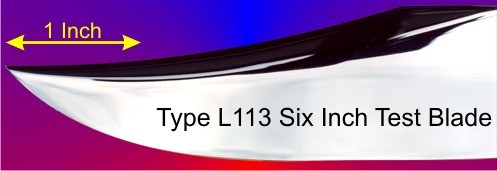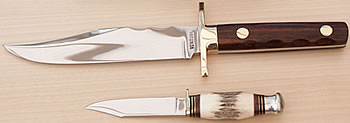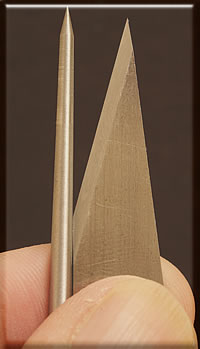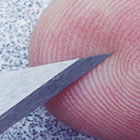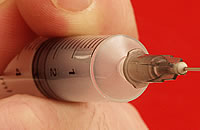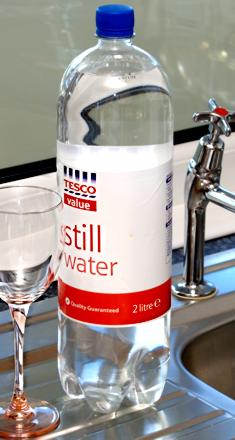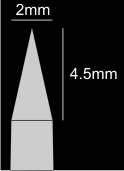 |
|||||||||||||||
|
|
|||||||||||||||
|
|
|
|
|||||||||||||||||||||||||||||||||||||||||||
|
|
|
Knives that pose the most serious threat to body armour systems are termed “engineered”. This in Plain English means a blade type that when “fully impacted” into a wooden block, would retain its shape and pointed effectiveness to be capable of being used again in its original, relatively undamaged state. If you were to examine most kitchen knives, you might determine that such “drawer knives” do not really qualify for inclusion. Fully impacting a bread knife into a wooden surface would probably snap the blade. In fact, most household knifes will bend if presented with any degree of force. The instant a Knife starts to bend is the physical energy point where the pointed knife weapon looses its penetration potential. In contrast to the above, knives purchased from specialist shops are quite different - they are made of high grade steel and drop into the “engineered” category. They are capable of retaining their shape at maximum human impact energy. Such blade types are what body armour systems must resist to qualify for certification. The newest test blade in the UK 2007 Police standard is just such a blade - with a pin sharp tip, and virtually “no give” in its construction. The Spike Test is considerably more severe than the knife test. Materials capable of preventing knives penetrating will often completely fail to stop pointed weapons of relatively small diameter. |
BODY ARMOUR UK - Stab Protection Levels Table |
|
This table relates to the current HOSDB 2007 (UK Police - “Home Office Scientific Development Branch” Standard). The Anti-Stab “Yellow Row” is produced in accordance with the PSDB 1993 Stab Standard |
|
||||||||||||||||||||||||||||||||||||||||||||||||||||
Anti-Stab Vests, Protection from most Knife Threats |
|
|
||||||||||||||||||||
|
We also ran some low threat ballistic trials against this anti-stab body armour. We reported a .38 Special at 200m/s and a .45 Colt at 180m/s. |
KR1+SP1 - Protects against - Knives, Slashing, Spiked Weapons & Hypodermic Syringes |
|
A 2007 Police Standard to protect from pointed weapons and knives. KR signifies "Knife resistance" and SP indicates "Spike Resistance". The picture below (left) shows both test weapons. The spike can be compared to "Ice Pick" or any weapon ground to a point. The material we use to produce our SP systems are also impermeable to attack from hypodermic syringes. |
|
|
|
||||||||||||||||||||||||
KR2+SP2 - Protects against - Knives, Slashing, Spiked Weapons & Hypodermic Syringes in a high risk environment |
|
|
KR3+SP3 - Protects against - Knives, Slashing, Spiked Weapons & Hypodermic Syringes in an extreme risk environment |
|
Requests for this specification are virtually nil compared to the above three protection levels. The KR3+SP3 is generally purchased in overt styles for a very specific purpose. It is the type of item that a police station might hold in small quantities to deal with situations of disarming with reasonable advance notice |
How to relate stab proof resistance with a “real world” example |
|
How much is a Joule of impact energy in a “real world” example that can be easily understood. You can choose any everyday object and drop it from a given height to calculate the Joules of impact energy. |
|
|
|
Using the 2 litre bottle of water on the right we can produce this dedicated table of drop heights. If the bottle was raised to 4 feet 3 inches from the floor (gap between floor and bottle) and then dropped, it would release 24 Joules of energy upon striking the floor. This table should help your appreciation of the “punch power” of the stab-vest test sabot at different impact energy levels. |
|
|
The weight of the Knife Test Sabot at 1.9 Kilograms with the P1/B test blade or spike fitted is sufficient to penetrate a human body and possibly cause fatality without being dropped from any height - the actual weight alone is sufficient to penetrate human skin and tissue. This answers the obvious question of “how many Joules of stabbing energy can cause a fatality” - less than one. |
|
|
|
|
Stab Vest, Stab Vests, Stab Proof Vest and Stab Proof Vests are common terms for body armour with a defined level of resistance to a knife or pointed weapon. The same also applies to bullet proof vest terminology - bullet proof vests have a defined level of ballistic resistance. |
| [Home] [Under Shirt] [Over Shirt] [Press] [Dual Purpose] [Helmets] [Plates] [Shields] [Standards] [UK Stab] [UK Ballistic] [NIJ Ballistic] [Utility] [Ordering] [Contact] |


